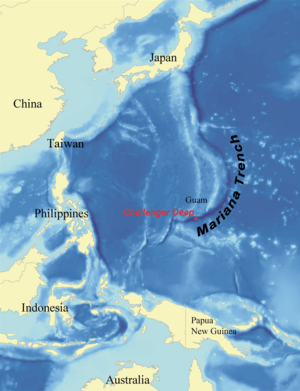Mariana Trench facts for kids
The Mariana Trench is the deepest known place in the ocean. It's also the deepest spot on Earth! It's located south and east of the Mariana Islands. This amazing trench goes down about 10,971 meters (that's almost 7 miles!). The western end of the trench is close to Guam.
The trench is super long, about 2,550 kilometers (1,580 miles), but it's pretty narrow, only about 69 kilometers (43 miles) wide on average.
Contents
Challenger Deep
The very deepest part of the Mariana Trench is called the Challenger Deep. It got its name from a British Royal Navy ship, the HMS Challenger. This ship explored the area between 1872 and 1876 and was the first to measure its incredible depth.
In 2009, a ship called the Kilo Moana used special sonar equipment to map the Challenger Deep. They found a spot that was 10,971 meters (6.82 miles) deep! The water pressure down there is more than a thousand times stronger than at the ocean's surface. Imagine trying to stand under a thousand elephants!
Only a few special vehicles have ever reached the bottom of the Challenger Deep.
- The first was a manned submarine called the Trieste in 1960.
- Then, two unmanned robot probes, Kaiko (from Japan) in 1995 and Nereus (from the U.S.) in 2009, explored the deep.
- In 2012, filmmaker James Cameron went down in his submarine, the Deepsea Challenger. He even filmed a 3D movie of the ocean floor!
Life in the Deep
Even in this extreme environment, life exists! The HMS Challenger expedition found tiny organisms called radiolaria in samples from the deep.
When the Trieste went down in 1960, its crew thought they saw a type of flatfish on the seabed. However, scientists now think it might have been a sea cucumber. Later, the Kaiko probe's camera spotted a sea cucumber, a scale worm, and a shrimp at the very bottom. The Nereus probe also saw a small polychaete worm.
Scientists also found many simple organisms in the mud samples collected by Kaiko at 10,900 meters (35,760 feet) deep. Most of these were soft-shelled organisms called foraminifera. It's hard for creatures with hard shells made of calcium carbonate to grow at such extreme depths because of the high pressure. This might be why most of the life found there has soft bodies.
How the Mariana Trench Formed
The Mariana Trench was created by the movement of huge pieces of Earth's crust called tectonic plates. It's like a giant puzzle where the pieces are always slowly moving.
At this location, the western edge of the Pacific Plate is sliding underneath the smaller Mariana Plate. This process is called subduction. The Pacific Plate is the largest tectonic plate on Earth. Its edge has been compacting and getting very dense for millions of years. This is why it sinks so much deeper than the Mariana Plate, creating the super deep Mariana Trench. The movement of these plates also helped form the Mariana Islands.
Interesting Facts About the Mariana Trench
- The Mariana Trench is named after the nearby Mariana Islands. These islands were named "Las Marianas" to honor Queen Mariana of Austria of Spain.
- The deepest point of the trench is more than 2 kilometers (1.2 miles) deeper than the peak of Mount Everest is tall!
- In 2009, the Mariana Trench was made a US National Monument. This helps protect its unique environment.
- As of 2022, 22 crewed (people inside) and seven uncrewed (robot) vehicles have explored the trench.
- The first crewed trip to the bottom was by the bathyscaphe Trieste on January 23, 1960. Don Walsh and Jacques Piccard were on board.
- Sadly, in 2019, explorer Victor Vescovo reported finding a plastic bag and candy wrappers at the very bottom of the trench. This shows how far human trash can travel.
Images for kids
-
The bathyscaphe Trieste, the first crewed vehicle to reach the bottom of the Mariana Trench
See also
 In Spanish: Fosa de las Marianas para niños
In Spanish: Fosa de las Marianas para niños





